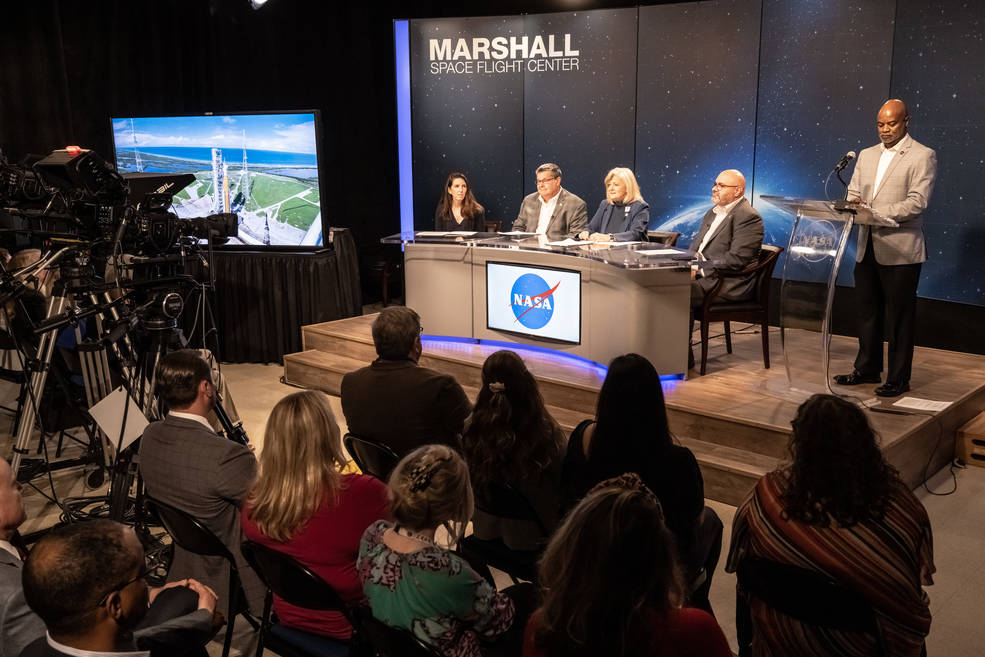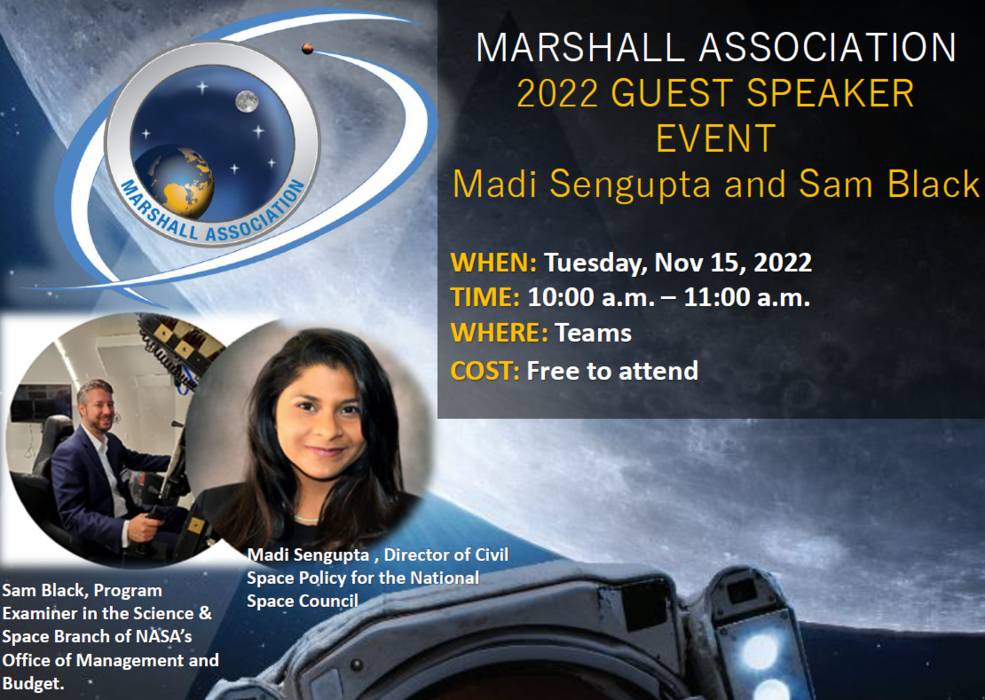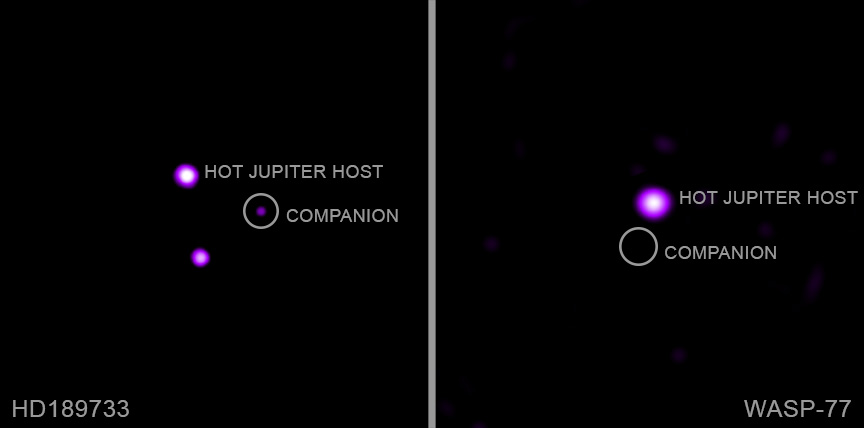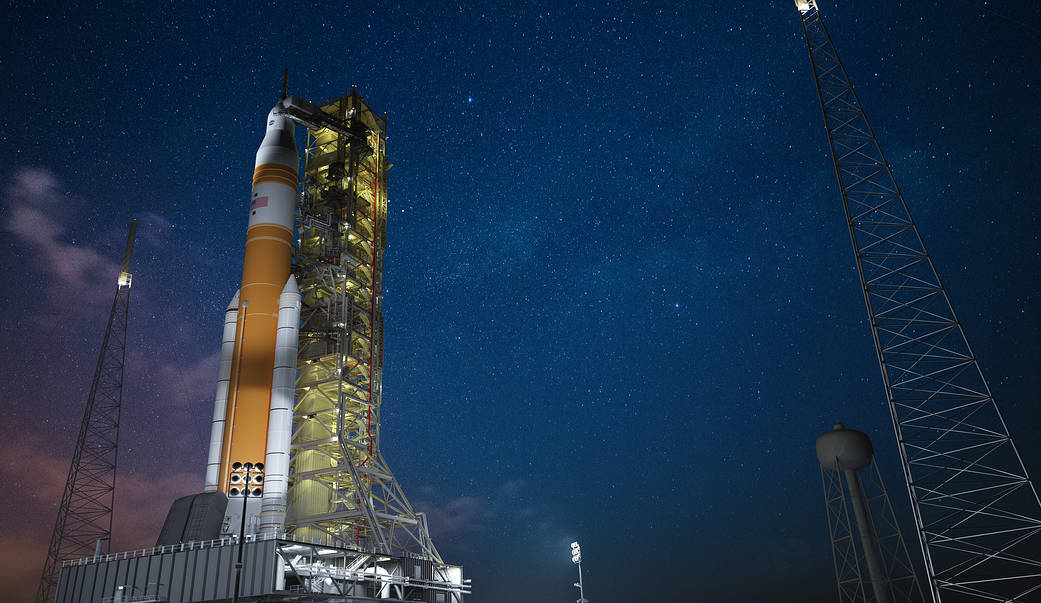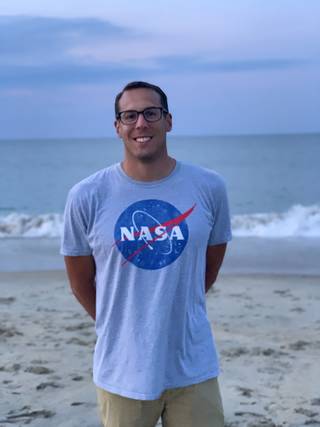The Marshall Star for November 9, 2022.
In This Week’s Star
- Marshall Leaders Answer Questions, Provide Updates During All-Hands
- NASA Prepares Rocket, Spacecraft Ahead of Tropical Storm Nicole, Re-targets Launch
- Marshall Association Speaker Series Event set for Nov. 15
- Chandra: Planets Can Be Anti-Aging Formula for Stars
- IXPE Reveals Shape, Orientation of Hot Matter Around Black Hole
- NASA Progresses Design of More Powerful SLS Rocket
- Research Scientist Brian Freitag Magnifies Benefits of Earth Observation Data
- 50 States: Bolts and Screws for Artemis
- Lunar Flashlight Featured on ‘This Week at NASA’
Marshall Leaders Answer Questions, Provide Updates During All-Hands
From left, NASA Marshall Space Flight Center Associate Director Rae Ann Meyer, Associate Director Larry Leopard, Director Jody Singer, Deputy Director Joseph Pelfrey, and Deputy Director of Human Resources Larry Mack address center team members during a hybrid all-hands Nov. 8. They discussed a variety of topics including the future of the hybrid workplace, plans for new buildings on the Marshall campus, updates on center strategy, and the status of the Artemis I mission. Singer and Meyer emphasized Marshall’s goal to keep the future of work flexible, while keeping in mind an individual’s role and specific mission work. “We are committed to maintaining flexibility, but we also have to implement our mission and look out for the health of our center – so, we’ll have to balance all three,” Meyer said. Leopard discussed the evolving center strategy, which includes more mission-focused partnerships in exploration development. Leopard highlighted some of Marshall’s major missions outside of the Space Launch System including human landing systems, cargo landers, habitation systems, life support systems, nuclear systems for Mars transit, cryogenic fluid management, and in-space and advanced manufacturing. “The main thing I want everyone to see at Marshall is you have a place in this future,” Leopard said. “When you see the details of the center strategy each and every one of you will see your place.” Singer commented on the demolition of Marshall’s administrative headquarters building for 63 years. “The demolition of 4200 did close a big chapter of our history, but it also cleared the way for new missions that will take us into the next era of deep space exploration.” Singer expressed excitement for the Artemis I launch attempt, now scheduled for Nov. 16, and described any launch as spectacular but a nighttime launch as especially breathtaking. (NASA/Mick Speer)
NASA Prepares Rocket, Spacecraft Ahead of Tropical Storm Nicole, Re-targets Launch
NASA is continuing to monitor Tropical Storm Nicole and has decided to re-target a launch for the Artemis I mission for Nov. 16, pending safe conditions for employees to return to work, as well as inspections after the storm has passed. Adjusting the target launch date will allow the workforce to tend to the needs of their families and homes, and provide sufficient logistical time to get back into launch status following the storm.
NASA’s Kennedy Space Center currently is in a HURCON (hurricane condition) III status, which includes securing facilities, property and equipment at the center, as well as briefing and deploying the ride-out team. As part of NASA’s hurricane preparedness protocol, a ride-out team includes a set of personnel who will remain in a safe location at Kennedy throughout the storm to monitor centerwide conditions, including the flight hardware for the Artemis I mission. Kennedy will release non-essential personnel at the HURCON II status as the agency continues to prioritize its employees in the Kennedy area.

Based on expected weather conditions and options to roll back ahead of the storm, the agency determined Nov. 6 the safest option for the launch hardware was to keep the Space Launch System (SLS) rocket and Orion spacecraft secured at the pad.
The SLS rocket is designed to withstand 85 mph winds at the 60-foot level with structural margin. Current forecasts predict the greatest risks at the pad are high winds that are not expected to exceed the SLS design. The rocket is designed to withstand heavy rains at the launch pad and the spacecraft hatches have been secured to prevent water intrusion.
In preparation for the storm, teams have powered down the Orion spacecraft, SLS core stage, interim cryogenic propulsion stage, and boosters. Engineers have also installed a hard cover over the launch abort system window, retracted and secured the crew access arm on the mobile launcher and configured the settings for the environmental control system on the spacecraft and rocket elements. Teams also are securing nearby hardware and performing walkdowns for potential debris in the area.
Teams are poised to resume work as soon as weather and Kennedy center status allows. Once back on-site, technicians will perform walkdowns and inspections at the pad to assess the status of the rocket and spacecraft as soon as practicable.
A launch during a two-hour window that opens at 1:04 a.m. EST/12:04 a.m. CST on Nov. 16 would result in a splashdown Dec. 11. If needed, NASA has a back-up launch opportunity Nov. 19, and will coordinate with the U.S. Space Force for additional launch opportunities.
The agency continues to rely on the most up to date information from the National Oceanic and Atmospheric Administration, U.S. Space Force, and the National Hurricane Center throughout its evaluations and continues to closely monitor conditions for the Kennedy area.
Check the Artemis I blog for updates.
Marshall Association Speaker Series Event set for Nov. 15
Madi Sengupta and Sam Black will be the guest speakers for the Marshall Association Speaker Series on Nov. 15. The meeting begins at 10 a.m. and can be heard via Teams link here. They will present a behind-the-scenes look at the National Space Council and NASA’s Office of Management and Budget, and how various entities interact with policy and budget to bring NASA’s missions and programs to life. Sengupta is the director of Civil Space Policy for the National Space Council, responsible for coordinating the development of strategies and recommendations on civil space policy and space-related issues for the White House. Previously, Sengupta worked as a policy analyst at NASA; a senior adviser in the Federal Aviation Administration’s Office of Commercial Space Transportation; and as the 2019 International Astronautical Congress program manager at the American Institute of Aeronautics and Astronautics. She started her career as a space station robotics instructor at NASA’s Johnson Space Center. Black joined OMB in 2016 as a program examiner in the Science & Space Branch. He is responsible for budget development and execution for NASA’s Aeronautics Research Mission Directorate, the Space Operations Mission Directorate, and the Exploration Systems Development Mission Directorate. He also serves as the focal point for reviewing and clearing NASA’s congressional testimony, reports, and briefings. In 2018, Black was detailed from OMB to the U.S. Senate Committee on Commerce, Science, and Transportation, where he worked on legislation related to commercial and civil space issues. Prior to his federal government service, Black spent more than five years at the Satellite Industry Association, where he started as director of policy before serving as acting president. For more information on the Marshall Association and how to join, visit their page on Inside Marshall. (NASA)
Chandra: Planets Can Be Anti-Aging Formula for Stars
Planets can force their host stars to act younger than their age, according to a new study of multiple systems using NASA’s Chandra X-ray Observatory. This may be the best evidence to date that some planets apparently slow down the aging process for their host stars.
While the anti-aging property of “hot Jupiters” (that is, gas giant exoplanets that orbit a star at Mercury’s distance or closer) has been seen before, this result is the first time it has been systematically documented, providing the strongest test yet of this exotic phenomenon.
“In medicine, you need a lot of patients enrolled in a study to know if the effects are real or some sort of outlier,” said Nikoleta Ilic of the Leibniz Institute for Astrophysics Potsdam (AIP) in Germany, who led this new study. “The same can be true in astronomy, and this study gives us the confidence that these hot Jupiters are really making the stars they orbit act younger than they are.”
A hot Jupiter can potentially influence its host star by tidal forces, causing the star to spin more quickly than if it did not have such a planet. This more rapid rotation can make the host star more active and produce more X-rays, signs that are generally associated with stellar youth.
As with humans, however, there are many factors that can determine a star’s vitality. All stars will slow their rotation and activity and undergo fewer outbursts as they age. Because it is challenging to precisely determine the ages of most stars, it has been difficult for astronomers to identify whether a star is unusually active because it is being affected by a close-in planet, making it act younger than it really is, or because it is actually young.
The new Chandra study led by Ilic approached this problem by looking at double-star (or “binary”) systems where the stars are widely separated but only one of them has a hot Jupiter orbiting it. Astronomers know that just like human twins, the stars in binary systems form at the same time. The separation between the stars is much too large for them to influence each other or for the hot Jupiter to affect the other star. This means they could use the planet-free star in the system as a control subject.
“It’s almost like using twins in a study where one twin lives in a completely different neighborhood that affects their health,” said co-author Katja Poppenhaeger, also of AIP. “By comparing one star with a nearby planet to its twin without one, we can study the differences in behavior of the same-aged stars.”
The team used the amount of X-rays to determine how “young” a star is acting. They looked for evidence of planet-to-star influence by studying almost three dozen systems in X-rays (the final sample contained 10 systems observed by Chandra and six by ESA’s XMM-Newton, with several observed by both). They found that the stars with hot Jupiters tended to be brighter in X-rays and therefore more active than their companion stars without hot Jupiters.
“In previous cases there were some very intriguing hints, but now we finally have statistical evidence that some planets are indeed influencing their stars and keeping them acting young,” said co-author Marzieh Hosseini, also of AIP. “Hopefully, future studies will help to uncover more systems to better understand this effect.”
A paper describing these results was published in the July 2022 issue of the Monthly Notices of the Royal Astronomical Society, and appears online.
NASA’s Marshall Space Flight Center manages the Chandra program. The Smithsonian Astrophysical Observatory’s Chandra X-ray Center controls science operations from Cambridge, Massachusetts, and flight operations from Burlington, Massachusetts.
IXPE Reveals Shape, Orientation of Hot Matter Around Black Hole
Cygnus X-1, discovered in 1964, was the first cosmic object ever identified as containing a black hole. Now, NASA telescopes have teamed up to reveal new details about the configuration of hot matter surrounding this famous black hole.
In a new study published in the journal Science, astronomers using NASA’s Imaging X-Ray Polarimetry Explorer (IXPE) mission data found that the flow of matter toward the black hole’s disk is more on edge than previously thought, meaning the edge of the disk would be pointed more toward Earth than expected.
IXPE, an international collaboration between NASA and the Italian Space Agency (ASI), has the special ability look at the polarization of X-ray light. Polarization is a property of light that tells us about the interconnected electric and magnetic fields that make up all wavelengths of light. The orientation and organization of these fields gives scientists valuable information about extreme objects like Cygnus X-1, such as how particles are accelerated around them.
One of the brightest X-ray sources in our galaxy, Cygnus X-1 has a black hole weighing 21 times the mass of the Sun. This low mass suggests the black hole was created when a star exploded a long time ago. The black hole is in orbit with a companion star weighing the equivalent of 41 Suns.
Matter is heated to millions of degrees as it is pulled toward the black hole. This hot matter glows in X-rays. Researchers are using measurements of the polarization of these X-rays to test and refine models that describe how black holes swallow matter, becoming some of the most luminous sources of light – including X-rays – in the universe.
“Previous X-ray observations of black holes only measured the arrival direction, arrival time, and energy of the X-rays from hot plasma spiraling toward the black holes,” said lead author Henric Krawczynski, professor of physics at Washington University in St. Louis and a faculty fellow in the university’s McDonnell Center for the Space Sciences. “IXPE also measures their linear polarization, which carries information about how the X-rays were emitted – and if, and where, they scatter off material close to the black hole.”
The scientists noted that a better understanding of the geometry of the plasma around a black hole can reveal much about the inner workings of black holes and how they accrete mass.
“These new insights will enable improved X-ray studies of how gravity curves space and time close to black holes,” Krawczynski said.
A black hole’s event horizon is the boundary beyond which no light, not even light from X-rays, can escape. The X-rays detected with IXPE are emitted by the hot matter, or plasma, in a 1,200-mile diameter region surrounding the 40 mile diameter event horizon of the black hole.
IXPE observed Cygnus X-1 from May 15 to May 21, 2022. Combining the IXPE data with concurrent observations from NASA’s Neutron star Interior Composition Explorer (NICER) and Nuclear Spectroscopic Telescope Array (NuSTAR) observatories in May and June 2022 allowed the authors to constrain the geometry – that is, the shape and location – of the plasma.
The researchers found that the plasma extends perpendicular to a two-sided, pencil-shaped plasma outflow, or jet, imaged in earlier radio observations. The alignment of the direction of the X-ray polarization and the jet lends strong support to the hypothesis that the processes in the bright region close to the black hole play a crucial role in launching the jet.
The observations match models predicting that the ring of hot plasma, called the “corona,” either sandwiches the disk of matter spiraling toward the black hole or replaces the inner portion of that disk. The new polarization data rule out models in which the black hole’s corona is a narrow plasma column or cone along the jet axis.
“The IXPE mission uses X-ray mirrors fabricated at NASA’s Marshall Space Flight Center and focal plane instrumentation provided by a collaboration of ASI, the National Institute for Astrophysics (INAF), and the National Institute for Nuclear Physics,” said co-author Fabio Muleri of INAF-IAPS. “Beyond Cygnus X-1, IXPE is being used to study a wide range of extreme X-ray sources, including mass-accreting neutron stars, pulsars and pulsar wind nebulae, supernova remnants, our galactic center, and active galactic nuclei. We’ve found a lot of surprises, and we’re having a lot of fun.”
NASA Progresses Design of More Powerful SLS Rocket
NASA reached a milestone toward enhancing the Space Launch System (SLS) rocket for future missions to deep space. Managers convened Nov. 3 for the critical design review of the Block IB evolved configuration of the rocket and determined teams will continue with design and initial production work for the evolved rocket design.
Beginning with Artemis IV, the SLS rocket will fly using the evolved Block 1B configuration with a more powerful Exploration Upper Stage (EUS) that includes larger fuel tanks and four RL10 engines, and a new stage adapter and payload adapter to send the crewed Orion spacecraft and large cargos to the Moon on a single mission. This Block 1B configuration will be capable of launching more than 80,000 pounds of payload to the Moon, includes new flight software capabilities, allows for more launch date opportunities, and enhances crew safety. It will be capable of lifting 40% more mass than the current Block I SLS configuration that will soon launch the uncrewed Artemis I flight test, as well as the Artemis II and III missions. The Block I configuration uses an interim cryogenic propulsion stage with one RL10 engine to provide in-space propulsion to send Orion to the Moon.
Early production work on an EUS structural test article is already in progress at NASA’s Michoud Assembly Facility, and teams recently delivered the interstage simulator to NASA’s Stennis Space Center for future testing. As teams at Michoud build SLS core stages for future Artemis missions, they are also testing the weld parameters on the recently manufactured EUS hydrogen tank barrel weld confidence article. These tests will allow engineers to construct the EUS structural test article that will be used to qualify the stage for flight. Manufacturing the upper stage is a collaborative effort between NASA and Boeing, the lead contractor for EUS and the SLS core stage.
Through Artemis, NASA will land the first woman and the first person of color on the lunar surface and establish long-term exploration on the Moon in preparation for human missions to Mars. SLS and NASA’s Orion spacecraft, along with the commercial human landing system and the Gateway in orbit around the Moon, are NASA’s backbone for deep space exploration. SLS is the only rocket that can send Orion, astronauts, and supplies to the Moon in a single mission.
Research Scientist Brian Freitag Magnifies Benefits of Earth Observation Data
(This is the eighth in a series of profiles on early career scientists in the Earth Science Branch at NASA’s Marshall Space Flight Center.)
By Dauna Coulter
When Brian Freitag was growing up, his heroes were Michael Jordan, Chipper Jones, Cal Ripken, and …Topper Shutt.
Who?
“That was the local ‘weather guy’ near Culpeper, Virginia, where I grew up,” Freitag said. “I put Topper right up there with my other heroes. When I was about 7, my parents took me to the TV station in Washington, D.C., to meet him.”
Freitag loved sports but was even more fascinated by weather. His mom, a teacher, installed and ran a weather station outside of her classroom and called in weather reports to another local TV station for the county where the Freitags lived.
“Sometimes she let me call in and talk to the forecasters,” he said. “And I would always watch storms roll in. When Tropical Storm Fran struck, I put out my rain bucket and went outside with my umbrella to stand in the storm. I used my fist as a fake microphone and pretended to give a live broadcast.”
After college, Freitag’s first job was with Society for Worldwide Interbank Financial Telecommunication (SWIFT). Deciding to follow his heart, Freitag left that position to pursue graduate school and his passion for Earth and atmospheric science.
As a research scientist at NASA’s Marshall Space Flight Center, he leads the data production team for the Harmonized Landsat Sentinel-2 products. These products take data from two extremely informative and useful Earth observation missions: Landsat (including platforms 8 and 9), and Sentinel 2 (including platforms A and B), so they can be used interchangeably. The team processes data from these satellites, transforming it into a product that provides a picture of the land surface every two or three days over a given location anywhere on the globe.
“We stage the data for NASA’s Land Processes Distributed Active Archive Center, or DAAC, for distribution to people like researchers, emergency managers, disaster responders, and farmers to help inform decisions,” Freitag said. “Farmers can view the greenness, and therefore the health, of their crops and determine where attention is needed. Fire officials can pinpoint where vegetation has dried out, increasing risk of wildfire. They can also detect fires and map their burned areas. Disaster officials can map flooding and land surface disturbance to help direct relief efforts.”
Freitag is also the deputy project lead for VEDA, short for Visualization, Exploration, and Data Analysis. The formally stated vision for VEDA is to “provide a unified open-source science cyberinfrastructure for data processing, visualization, exploration, and GIS capabilities (re-)using ecosystem of tools and services with NASA data on the cloud.” Simply put, VEDA uses an interactive dashboard to display images and information about flooding, drought, wildfire risk, active wildfire location, and much more. The dashboard includes tools allowing users to interact with and learn from the data, selecting, for example, information specific to regions of interest.
Asked about his strengths, Freitag said, “At work, I put the team first and encourage cooperation. In my personal life, I try to put the needs of others first.”
Describing himself as “laid back,” he says he needs to improve himself by reading more. A member of the college swim team all through school meant scant free time. And that free time hasn’t expanded much. He has a new baby boy.
And it’s a safe bet that boy will be fascinated by weather.
Coulter, a Media Fusion employee, supports Marshall’s Office of Strategic Analysis & Communications.
50 States: Bolts and Screws for Artemis
Every state in America has contributed to Artemis missions. The smallest parts – like a bolt or screw – play a huge role in spaceflight. Here are a few companies that are helping NASA secure the elements of the Space Launch System rocket and the Orion spacecraft together as we launch this new era of space exploration. (NASA)
Lunar Flashlight Featured on ‘This Week at NASA’
NASA’s Lunar Flashlight, a small satellite that will use lasers to search for water ice inside the darkest craters at the Moon’s South Pole, is featured in “This Week @NASA,” a weekly video program broadcast on NASA-TV and posted online.
Water ice could provide a valuable resource for astronauts on future Moon missions. Lunar Flashlight is targeted for launch in November. No larger than a briefcase, it is an innovative, low-cost CubeSat developed and managed by NASA’s Jet Propulsion Laboratory. NASA’s Marshall Space Flight Center led the design of the compact propulsion system and oversaw hardware development in its in-house facilities and at Plasma Processes LLC of Huntsville and Flight Works of Irvine, California.
View this and previous episodes at “This Week @NASA” on NASA’s YouTube page.


























